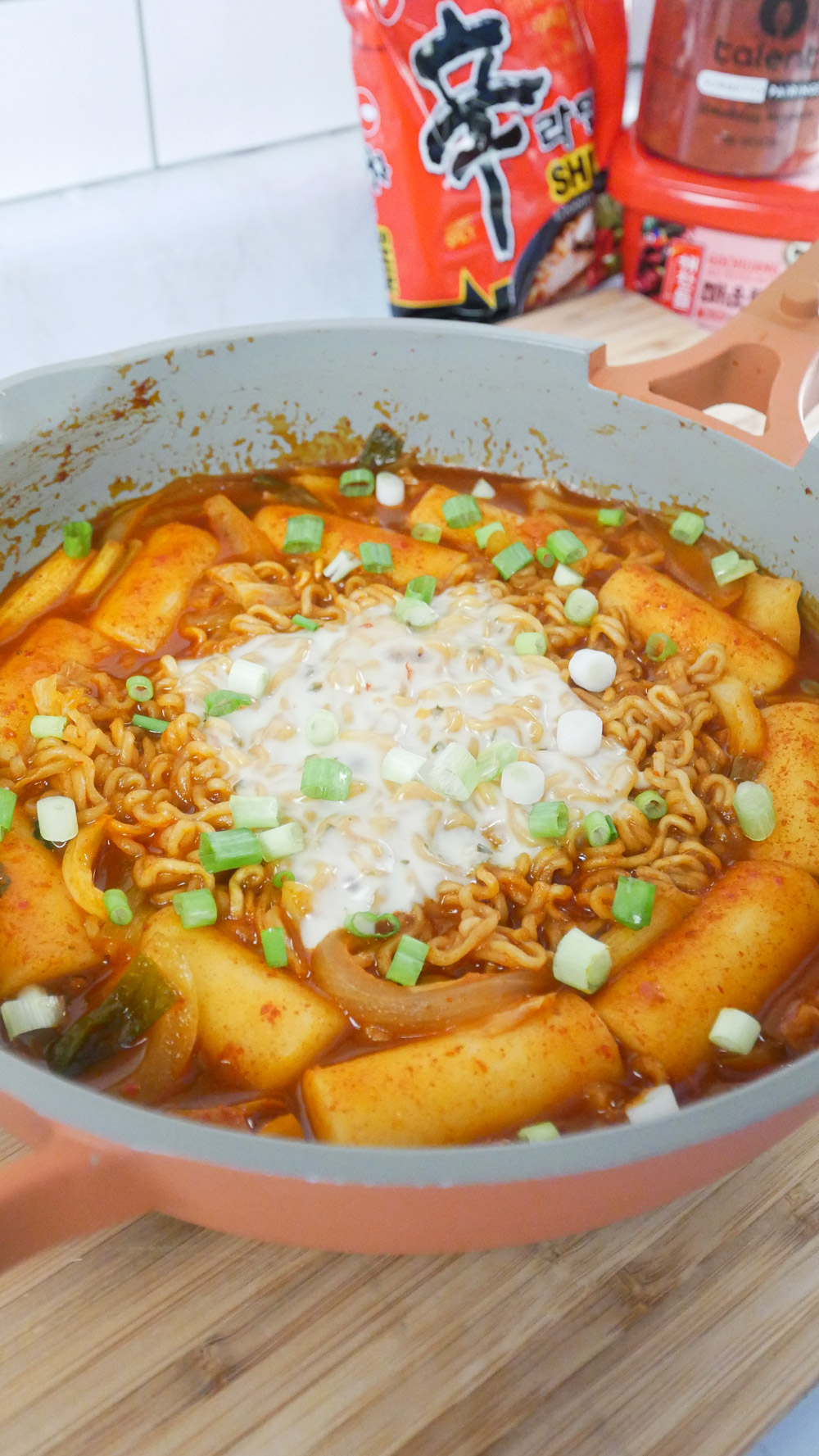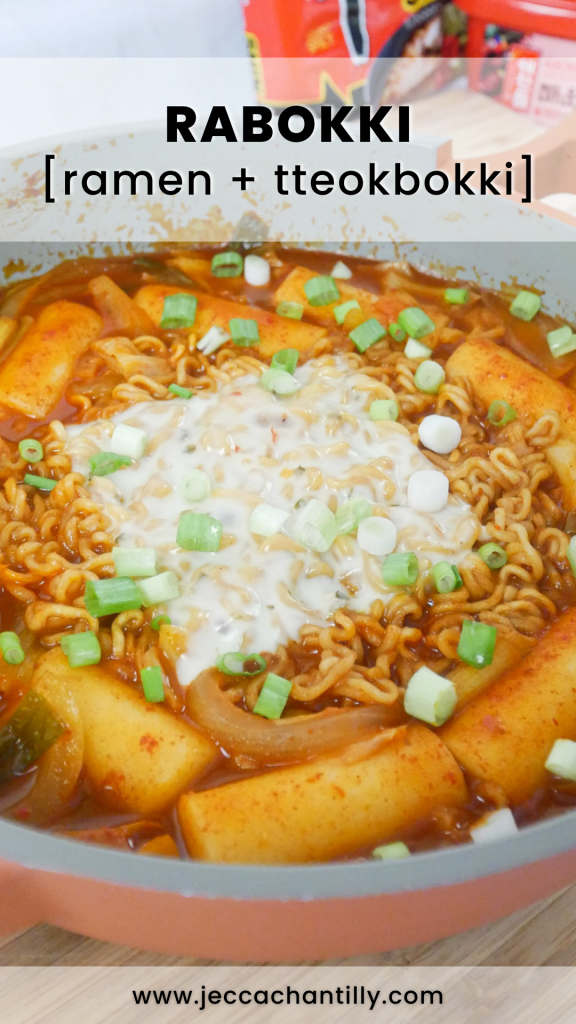If you like tteokbokki ‘Spicy Korean rice cakes’ and you like ramyun, you’re gonna love rabokki! I mean, what’s not to love? You get the best of both worlds all in one bite! This delicious fusion is a blend of spicy, sweet, and savory notes which makes for an irresistible blend of flavors. Once you have a bite of the chewy rice cakes or ‘tteok’ and comforting noodles in the spicy, sweet, and savory sauce, it’ll leave your taste buds craving more!
The key ingredient is to marry the tteokbokki and ramen together with a little bit of the ramen powder. I like using Shin Ramen because it’s my favorite ramen but you can use any brand or type of ramen you like. Adding a slice of cheese on top builds an extra bomb of flavor, so I highly recommend adding it in. Pepperjack cheese is my go-to – feel free to use any cheese you prefer!
Why you’ll love this recipe
If you love bold and loud flavors, rabokki is the dish for you. This Korean fusion combines two of the most popular classics of Korean cuisine – ramyun and tteokbokki. And the key ingredient is the ramyun seasoning packet! The flavors of the seasoning packet complement and enhances the traditional flavors of tteokbokki, making them a perfect match. Plus, the chewiness of the tteok is a nice complement to the noodles, making it the ultimate comforting dish.
I like using Shin Ramen because it’s my favorite ramyun but you can use any brand or type of ramyun you like! Some other popular brands include Jin Ramen and Neoguri. If you wanted to take this dish to the next level, you can also add a slice of cheese. It adds another layer of richness which I highly recommend! Pepperjack cheese is my go-to but feel free to use any cheese you desire.
How do I prepare Rabokki?
Making rabboki is just as easy and convenient as making your favorite ramyun. To get started, just follow the steps below:
Step 1: Make anchovy stock
In a pot, combine water, anchovies, kelp, and onion. Bring the mixture to a boil over medium heat for 20 minutes or until the liquid reduces to half (about 3 cups). Then, strain and set aside.
Step 2: Make the sauce
To prepare the sauce, combine gochujang, coarse gochugaru, fine gochugaru, soy sauce, and sugar. Mix until they’re well combined.
Step 3: Season the anchovy stock
Pour the anchovy stock into a deep pan, then add the sauce mixture and half a packet of the ramyun seasoning packet.
Step 4: Assemble the ingredients
In the same pan, toss in the tteok (rice cake), cabbage, onion, and scallions. Allow it to cook for 2 to 3 minutes.
When the liquid has slightly reduced, add the instant ramen and cook noodles to your desired doneness. Then, add the cheese and cover until it’s melted.
Step 5: Serve!
Garnish with scallions and serve. Enjoy!
Cooking Tips for Rabokki
To ensure your rabokki comes out perfect every time, here are a few tips and tricks you can keep in mind when making this recipe:
- I highly recommend using anchovy broth as the base of the sauce. It adds a ton of flavor when compared to water. You can also substitute anchovy broth with no sodium vegetable broth or chicken broth.
- Make sure to remove the innards of the dried anchovies before making the broth. The innards have an unpleasant bitterness which you don’t want in the broth. Don’t throw out the heads though! They have a ton of flavor.
- To extend the shelf life of the dried anchovies, I recommend storing them in the freezer. This is what my mom does!
- Feel free to adjust the amount of gochugaru based on your spice level preference. Keep in mind that the ramyun seasoning packet (if using Shin Ramen) is also spicy so adjust the gochugaru to reduce or increase the spiciness.
- To make this a heartier meal, you can also add fish cakes, sausages, hot dogs, bacon, or a variety of vegetables. Experiment with ingredients that you like!
- The ramyun noodles tend to overcook quickly so be sure to add the noodles when the rest of the ingredients are cooked all the way through.
Ingredients & Substitutions
Cabbage: cabbage is a traditional tteokbokki ingredient and is a clever way of sneaking in your veggies. It also adds a natural sweetness to the dish which helps balance out the spiciness and savoriness.
Onion: similar to cabbage, onions help add sweetness and aroma to the sauce. You can substitute onion with more scallions.
Scallions: scallions are also a traditional ingredient in tteokbokki.
Tteok (rice cakes): there are many variations of Korean rice cakes and the one you want to use for this recipe is the cylindrical shape. You’ll be able to find them in the refrigerated section of any Korean grocery store.
Instant ramyun noodles: I like using Shin Ramen for this recipe but you can use any other brand that you like! Just make sure that it’s a spicy one.
Ramyun powder: I usually use the seasoning powder that comes with the ramyun packet. It enhances and complements the sauce deliciously!
Cheese: you can use any cheese you like including pepperjack, cheddar, mozzarella, and more!
Gochujang: gochujang is a traditional ingredient in tteokbokki which adds umami and a subtle sweetness. I recommend using the mild version of gochujang so that you have more control of the spiciness. Even as a spicy food lover, I find that the hot version is a bit too spicy.
Coarse gochugaru: the gochugaru is what makes this dish spicy. For a milder dish, reduce the amount of gochugaru added. For a spicier dish, increase the amount of gochugaru added.
Fine gochugaru: the fine gochugaru is added to deepen the red color in the dish. You can substitute this with coarse gochugaru.
Dried anchovies: the dried anchovies are used to make the broth for the base of the sauce. It adds a depth of umami flavors to the dish, which makes this extra delicious. However, if you wanted to speed up the process, you can add 1 to 2 teaspoons of my Homemade Anchovy Powder recipe instead! Otherwise, you can substitute the anchovy broth with no sodium chicken broth or vegetable broth.
Kelp: the kelp or ‘dashima‘ also enhances the umami flavors and savoriness of the dish. It’s a common ingredient when making Korean anchovy broth but if you don’t have any, you can add a couple more dried anchovies or use dried shiitake mushrooms.
Frequently Asked Questions
What is anchovy broth?
If you’re not familiar, anchovy broth is a traditional base for several dishes in Korean cuisine. It’s often used for building the flavors of soups and stews because dried anchovies and kelp add a deliciously salty and umami taste. Just make sure you remove the innards of the dried anchovies before making the broth so it doesn’t turn out bitter! Other than that, it’s pretty easy to make, so you can make a batch in advance and store them in the freezer to use whenever you’re making Korean dishes like this one!
What is ‘tteok’ made of?
‘Tteok’ or garaetteok is a cylindrical white rice cake that’s made from short-grain rice flour, starch, water, and salt. To get its distinct chewy texture, the mixture is turned into a dough that’s steamed before pounding and kneading. It’s then rolled into a cylindrical shape, and cut so it’s easier to eat. Aside from this recipe, you can also incorporate tteok into several savory dishes, like stir-fries, soups, and stews, so it’s always good to have some in your freezer!
Can I make Rabokki vegetarian or vegan?
Yes! To make this vegetarian and vegan-friendly, you just need to substitute the anchovy broth with vegetable broth. If you wanted to make your own vegetable broth at home, you could use dried shiitake mushrooms and kelp.
Coarse vs fine gochugaru
Coarse and fine gochugaru are both made from the same red chili peppers and you can tell them apart by the size of their grind. Although they don’t have any difference in flavor, both play a different role depending on the dish you’re making. Fine gochugaru is commonly used in soups and sauces where you don’t want to spot any chili flakes. It’s also used to add a more vibrant color to the dish. Coarse gochugaru on the other hand is commonly use for kimchi, side dishes, and stews.
Although you’re free to interchange them in a recipe, I like adding both to this recipe for their flavor and color!
Can you store Rabokki in the fridge?
While rabokki is best enjoyed fresh, you can store leftover rabokki in the fridge. When storing, just make sure to keep it in an airtight container. Keep in mind that the noodles and rice cakes will get soggy because it tends to absorb the sauce. To reheat, heat the rabokki in a pan over the stovetop or microwave for 1 to 2 minutes until it’s heated through. If it’s too thick, add a bit of water to loosen up the sauce.
Looking for more easy and delicious noodle recipes?
1. Ginger Scallion Noodles – don’t be fooled by the simplicity of this noodle dish. It’s packed with a ton of aromatics and spices and only takes 20 minutes to make!
2. Char Siu Pork Noodle Soup – if you’re looking for a comforting bowl of noodle soup, you have to give this recipe a try! Topped with succulent and juicy char siu for the ultimate meal.
3. Spicy Seafood Noodle Soup – if you’re looking for something spicy and refreshing, I highly recommend giving this spicy seafood noodle soup a try!
4. Shrimp Pan Fried Noodle – take a break from soft noodles and hot broth, and try this crispy Hong Kong classic. It’s packed with succulent shrimp and a medley of veggies that are smothered with a thick seafood gravy that’s to die for!
5. Taiwanese Sesame Noodles – ‘ma jiang mian’ or Taiwanese sesame noodles is one of those quick 10-minute meals that you can make any day of the week. This dish has a nice combination of salty and sweet flavors, plus it’s vegetarian!

Rabokki
Ingredients
- 1/2 cup cabbage chopped
- 1/4 cup onion sliced
- 2 scallions chopped
- 8-10 tteok (rice cakes)
- 1 instant ramen noodle
- 1/2 packet ramen powder
- 3 cups anchovy broth or water
- cheese optional
Sauce
- 1 tbsp gochujang Korean red pepper paste
- 1 tbsp coarse gochugaru Korean red pepper flakes
- 1/2 tbsp fine gochugaru Korean red pepper powder
- 1 tbsp soy sauce
Anchovy Broth
- 6 cups water
- 8 dried anchovies innards removed
- 5 small pieces of kelp
- 1/2 medium onion
Instructions
- In a pot, combine water, anchovies, kelp and onion. Bring this to a boil over medium heat for 20 minutes or until the liquid has reduced to half (about 3 cups). Strain and set aside.
- To prepare the sauce, combine gochujang, coarse gochugaru, fine gochugaru, soy sauce, and sugar. Mix until well combined.
- Pour the anchovy stock in a deep pan. Add the sauce mixture and half packet of ramen powder.
- Toss in the tteok, cabbage, onion, and scallions. Cook for 2-3 minutes.
- When the liquid has slightly reduced, add the instant ramen and cook noodles to your desired doneness.
- Add cheese and cover until melted.
- Serve and enjoy!
Pin & save this recipe for later!
